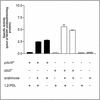Propionyl coenzyme A is a common intermediate in the 1,2-propanediol and propionate catabolic pathways needed for expression of the prpBCDE operon during growth of Salmonella enterica on 1,2-propanediol
- PMID: 12700259
- PMCID: PMC154405
- DOI: 10.1128/JB.185.9.2802-2810.2003
Propionyl coenzyme A is a common intermediate in the 1,2-propanediol and propionate catabolic pathways needed for expression of the prpBCDE operon during growth of Salmonella enterica on 1,2-propanediol
Abstract
The studies reported here identify propionyl coenzyme A (propionyl-CoA) as the common intermediate in the 1,2-propanediol and propionate catabolic pathways of Salmonella enterica serovar Typhimurium LT2. Growth on 1,2-propanediol as a carbon and energy source led to the formation and excretion of propionate, whose activation to propionyl-CoA relied on the activities of the propionate kinase (PduW)/phosphotransacetylase (Pta) enzyme system and the CobB sirtuin-controlled acetyl-CoA and propionyl-CoA (Acs, PrpE) synthetases. The different affinities of these systems for propionate ensure sufficient synthesis of propionyl-CoA to support wild-type growth of S. enterica under low or high concentrations of propionate in the environment. These redundant systems of propionyl-CoA synthesis are needed because the prpE gene encoding the propionyl-CoA synthetase enzyme is part of the prpBCDE operon under the control of the PrpR regulatory protein, which needs 2-methylcitrate as a coactivator. Because the synthesis of 2-methylcitrate by PrpC (i.e., the 2-methylcitrate synthase enzyme) requires propionyl-CoA as a substrate, the level of propionyl-CoA needs to be raised by the Acs or PduW-Pta system before 2-methylcitrate can be synthesized and prpBCDE transcription can be activated.
Figures




Similar articles
-
Studies of regulation of expression of the propionate (prpBCDE) operon provide insights into how Salmonella typhimurium LT2 integrates its 1,2-propanediol and propionate catabolic pathways.J Bacteriol. 1998 Dec;180(24):6511-8. doi: 10.1128/JB.180.24.6511-6518.1998. J Bacteriol. 1998. PMID: 9851993 Free PMC article.
-
Characterization of the propionyl-CoA synthetase (PrpE) enzyme of Salmonella enterica: residue Lys592 is required for propionyl-AMP synthesis.Biochemistry. 2002 Feb 19;41(7):2379-87. doi: 10.1021/bi015647q. Biochemistry. 2002. PMID: 11841231
-
prpR, ntrA, and ihf functions are required for expression of the prpBCDE operon, encoding enzymes that catabolize propionate in Salmonella enterica serovar typhimurium LT2.J Bacteriol. 2000 Feb;182(4):905-10. doi: 10.1128/JB.182.4.905-910.2000. J Bacteriol. 2000. PMID: 10648513 Free PMC article.
-
Acetyl-coenzyme A synthetase (AMP forming).Cell Mol Life Sci. 2004 Aug;61(16):2020-30. doi: 10.1007/s00018-004-3448-x. Cell Mol Life Sci. 2004. PMID: 15316652 Free PMC article. Review.
-
Structure and function of enzymes involved in the anaerobic degradation of L-threonine to propionate.J Biosci. 2007 Sep;32(6):1195-206. doi: 10.1007/s12038-007-0121-1. J Biosci. 2007. PMID: 17954980 Review.
Cited by
-
Potential of gut-derived short-chain fatty acids to control enteric pathogens.Front Microbiol. 2022 Sep 20;13:976406. doi: 10.3389/fmicb.2022.976406. eCollection 2022. Front Microbiol. 2022. PMID: 36204607 Free PMC article. Review.
-
Bacterial microcompartments: widespread prokaryotic organelles for isolation and optimization of metabolic pathways.Mol Microbiol. 2015 Oct;98(2):193-207. doi: 10.1111/mmi.13117. Epub 2015 Aug 3. Mol Microbiol. 2015. PMID: 26148529 Free PMC article. Review.
-
Characterization of the PduS cobalamin reductase of Salmonella enterica and its role in the Pdu microcompartment.J Bacteriol. 2010 Oct;192(19):5071-80. doi: 10.1128/JB.00575-10. Epub 2010 Jul 23. J Bacteriol. 2010. PMID: 20656910 Free PMC article.
-
Exogenous or L-rhamnose-derived 1,2-propanediol is metabolized via a pduD-dependent pathway in Listeria innocua.Appl Environ Microbiol. 2008 Nov;74(22):7073-9. doi: 10.1128/AEM.01074-08. Epub 2008 Sep 19. Appl Environ Microbiol. 2008. PMID: 18805996 Free PMC article.
-
The N Terminus of the PduB Protein Binds the Protein Shell of the Pdu Microcompartment to Its Enzymatic Core.J Bacteriol. 2017 Mar 28;199(8):e00785-16. doi: 10.1128/JB.00785-16. Print 2017 Apr 15. J Bacteriol. 2017. PMID: 28138097 Free PMC article.
References
-
- Bobik, T. A., G. D. Havemann, R. J. Busch, D. S. Williams, and H. C. Aldrich. 1999. The propanediol utilization (pdu) operon of Salmonella enterica serovar Typhimurium LT2 includes genes necessary for formation of polyhedral organelles involved in coenzyme B12-dependent 1,2-propanediol degradation. J. Bacteriol. 181:5967-5975. - PMC - PubMed
-
- Brämer, C. O., L. F. Silva, J. G. C. Gomez, H. Priefert, and A. Steinbüchel. 2002. Identification of the 2-methylcitrate pathway involved in the catabolism of propionate in the polyhydroxyalkanoate-producing strain Burkholderia sacchari IPT101T and analysis of a mutant accumulating a copolyester with higher 3-hydroxyvalerate content. Appl. Environ. Microbiol. 68:271-279. - PMC - PubMed
Publication types
MeSH terms
Substances
Grants and funding
LinkOut - more resources
Full Text Sources
Other Literature Sources
Molecular Biology Databases

